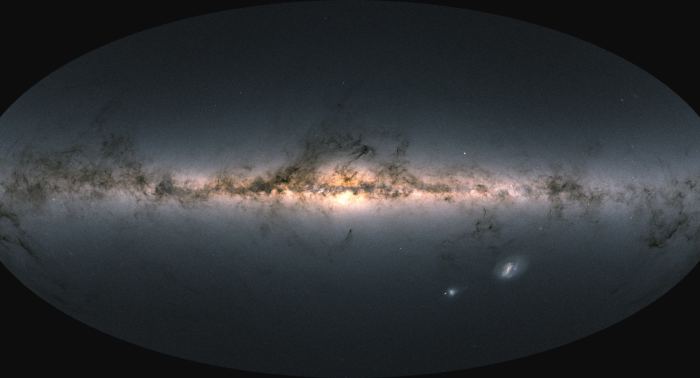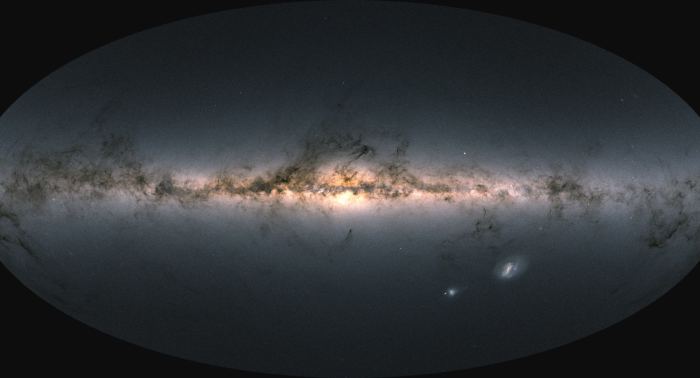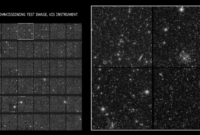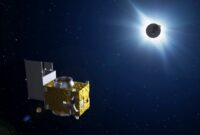Esa gaia new space universe data – ESA Gaia: New Space Data Unlocking the Universe, this mission is changing our understanding of the cosmos. It’s like having a giant cosmic telescope, meticulously mapping the Milky Way galaxy, revealing the secrets of stars, and even helping us understand the universe’s evolution.
The European Space Agency’s (ESA) Gaia mission is a game-changer in astronomy. This spacecraft, equipped with cutting-edge instruments, is meticulously mapping the Milky Way galaxy, measuring the positions, distances, and motions of billions of stars. This unprecedented data trove is providing astronomers with an unparalleled view of our galactic home, revolutionizing our understanding of its structure, evolution, and even the origins of the universe.
ESA Gaia Mission Overview

The ESA Gaia mission is a space observatory dedicated to creating the most precise and comprehensive three-dimensional map of the Milky Way galaxy. Its primary objective is to understand the origin, evolution, and structure of our galaxy by studying the positions, motions, and properties of billions of stars.
The Gaia Spacecraft
The Gaia spacecraft is a complex and sophisticated instrument, designed to achieve its ambitious scientific goals. It consists of two telescopes, each with a 1.45-meter diameter primary mirror, and a large focal plane array containing over 1 billion pixels. These telescopes work in tandem to measure the positions, distances, and motions of stars with unprecedented accuracy.
Gaia’s Instruments
Gaia is equipped with three main instruments:
- Astrometric Instrument:This instrument measures the precise positions and distances of stars with an accuracy of a few micro-arcseconds. This allows for the creation of a highly detailed three-dimensional map of the Milky Way.
- Photometric Instrument:This instrument measures the brightness of stars in various colors, allowing for the determination of their temperatures, compositions, and ages. This data provides insights into the evolution of stars and the chemical composition of the Milky Way.
- Spectroscopic Instrument:This instrument measures the spectrum of light emitted by stars, revealing information about their radial velocities, chemical compositions, and surface gravity. This data helps to understand the motions of stars and their evolutionary stages.
Gaia’s Scientific Objectives
The Gaia mission aims to address a wide range of scientific questions, including:
- Mapping the Milky Way:Gaia’s primary objective is to create a precise and comprehensive map of the Milky Way galaxy, revealing its structure, composition, and evolution.
- Understanding Stellar Evolution:By studying the properties of billions of stars, Gaia will provide insights into the processes of stellar evolution, including birth, life, and death.
- Exploring the Galaxy’s Dynamics:Gaia’s measurements of stellar motions will reveal the dynamics of the Milky Way, including the distribution of dark matter and the presence of gravitational waves.
- Discovering New Objects:Gaia is expected to discover new objects in the Milky Way, including faint stars, white dwarfs, and brown dwarfs, as well as distant galaxies and quasars.
- Testing Fundamental Physics:Gaia’s precise measurements can be used to test fundamental laws of physics, such as the theory of gravity and the expansion of the universe.
Gaia Data and its Significance
Gaia, the European Space Agency’s ambitious space observatory, has revolutionized our understanding of the Milky Way galaxy. Its primary mission is to create the most precise and comprehensive three-dimensional map of our galaxy ever achieved. To accomplish this, Gaia meticulously gathers a wealth of data about stars, providing astronomers with an unprecedented view of the Milky Way’s structure, evolution, and composition.
Types of Data Collected by Gaia
Gaia’s data collection encompasses three primary categories: astrometry, photometry, and spectroscopy.
- Astrometry:Gaia measures the positions, distances, and motions of stars with unparalleled accuracy. This precise measurement of stellar positions and their changes over time allows astronomers to determine the stars’ distances from Earth, their proper motions (their movements across the sky), and their radial velocities (their movements towards or away from Earth).
This data is crucial for understanding the Milky Way’s structure, the dynamics of star clusters, and the evolution of the galaxy.
- Photometry:Gaia measures the brightness of stars in multiple colors. This information reveals the stars’ temperatures, compositions, and ages. By analyzing the brightness of stars in different colors, astronomers can determine their surface temperatures, their chemical compositions, and their evolutionary stages.
This data provides insights into the formation and evolution of stars, the distribution of different types of stars in the galaxy, and the processes that drive stellar evolution.
- Spectroscopy:Gaia analyzes the light from stars to determine their chemical compositions and radial velocities. This information provides insights into the stars’ chemical abundances, their ages, and their motions within the galaxy. By analyzing the spectrum of light emitted by stars, astronomers can identify the elements present in their atmospheres and determine their velocities.
This data is essential for understanding the chemical evolution of the galaxy, the formation of stars, and the dynamics of the Milky Way’s stellar populations.
Scientific Value of Gaia Data
The scientific value of Gaia data lies in its ability to address fundamental questions about the Milky Way galaxy. It allows astronomers to:
- Map the Milky Way’s structure:Gaia’s precise measurements of stellar positions and motions enable the creation of a detailed three-dimensional map of the Milky Way, revealing its spiral arms, its central bulge, and its surrounding halo. This map provides a comprehensive view of the galaxy’s structure and allows astronomers to study the distribution and dynamics of its stellar populations.
- Trace the Milky Way’s evolution:By analyzing the motions and chemical compositions of stars, astronomers can reconstruct the history of the Milky Way, tracing its formation and evolution over billions of years. This data provides insights into the processes that led to the galaxy’s current state and helps us understand the evolution of galaxies in general.
- Study the formation and evolution of stars:Gaia’s data provides a wealth of information about individual stars, including their ages, compositions, and motions. This data allows astronomers to study the processes of star formation, the evolution of stars, and the distribution of different types of stars in the galaxy.
For descriptions on additional topics like oxford physicists enlist atomic clocks in the hunt for dark matter, please visit the available oxford physicists enlist atomic clocks in the hunt for dark matter.
- Explore the dynamics of star clusters:Gaia’s data enables the study of star clusters, groups of stars that formed together. By analyzing the motions and compositions of stars within clusters, astronomers can understand their formation, evolution, and the forces that govern their dynamics. This information provides insights into the processes of star formation and the evolution of stellar systems.
- Identify and characterize exoplanets:Gaia’s precise astrometry measurements can detect the subtle gravitational tugs of planets on their host stars. This data allows astronomers to identify and characterize exoplanets, planets orbiting stars other than our Sun. This research helps us understand the diversity of planetary systems and the conditions for the formation and evolution of planets.
Key Scientific Discoveries Enabled by Gaia Data
Gaia’s data has already led to significant discoveries, including:
- The discovery of new star streams:Gaia has revealed the existence of numerous stellar streams, elongated trails of stars that were once part of star clusters or dwarf galaxies that were disrupted by the Milky Way’s gravitational pull. These streams provide insights into the galaxy’s formation and evolution.
- The identification of new dwarf galaxies:Gaia has discovered several new dwarf galaxies, small galaxies that orbit the Milky Way. These discoveries provide insights into the distribution of galaxies in the local universe and the processes that drive galaxy formation.
- The measurement of the Milky Way’s rotation:Gaia’s data has allowed astronomers to measure the Milky Way’s rotation with unprecedented accuracy. This measurement provides insights into the galaxy’s mass distribution and the dynamics of its stellar populations.
- The identification of stars with unusual compositions:Gaia’s data has revealed the existence of stars with unusual chemical compositions, providing insights into the processes of star formation and the evolution of the Milky Way.
- The detection of exoplanets:Gaia’s data has enabled the detection of several exoplanets, including planets that are orbiting stars in binary systems. This data provides insights into the diversity of planetary systems and the conditions for the formation and evolution of planets.
New Space and its Impact on Gaia
The emergence of New Space, characterized by private companies venturing into space exploration, has significantly impacted the landscape of space missions like Gaia. This shift has brought about new opportunities and challenges, transforming the traditional approach to space exploration.
Traditional Space Agencies vs. New Space Companies
The traditional approach to space exploration has been dominated by government-funded space agencies, such as NASA, ESA, and Roscosmos. These agencies have historically played a crucial role in advancing space technology and scientific discovery. However, the rise of New Space companies, such as SpaceX, Blue Origin, and Virgin Galactic, has introduced a new dynamic to the space industry.
- Focus:Traditional space agencies prioritize scientific research and exploration, while New Space companies often focus on commercial applications, such as satellite communication, space tourism, and launching payloads for other companies.
- Funding:Traditional space agencies rely heavily on government funding, while New Space companies are primarily funded by private investors and venture capitalists.
- Innovation:New Space companies are known for their agility and rapid innovation, often adopting cutting-edge technologies and approaches that challenge traditional practices.
- Accessibility:New Space companies have made space more accessible by lowering launch costs and offering services like rideshare launches, allowing smaller organizations and researchers to participate in space exploration.
The Role of New Space in Future Missions Like Gaia, Esa gaia new space universe data
New Space companies can play a significant role in supporting future space missions like Gaia. Their capabilities in areas such as launch services, satellite technology, and data analysis can contribute to the success of ambitious space projects.
- Launch Services:New Space companies like SpaceX and Blue Origin offer cost-effective and reliable launch services, enabling the deployment of larger and more complex spacecraft like Gaia.
- Satellite Technology:New Space companies are developing innovative satellite technologies, such as miniaturized satellites and advanced sensors, which can be integrated into future space missions to enhance their capabilities.
- Data Analysis:New Space companies have expertise in big data analysis and artificial intelligence, which can be applied to process and analyze the vast amounts of data collected by missions like Gaia.
Examples of New Space Contributions to Gaia
The success of Gaia relies on a network of ground stations to receive and process the data collected by the spacecraft. SpaceX’s Starlink constellation of satellites provides a potential solution for enhancing communication with the Gaia spacecraft, enabling faster and more reliable data transmission.
Data Analysis and Interpretation
The vast amount of data collected by Gaia presents a unique challenge and opportunity for astronomers. Analyzing this data requires sophisticated methods and techniques to extract meaningful insights about the Milky Way and its constituents.
Data Analysis Process
The analysis of Gaia data involves a series of steps, each contributing to a deeper understanding of the Milky Way.
- Data Processing and Calibration:Raw data from Gaia’s instruments undergoes extensive processing and calibration to remove noise and systematic errors. This involves correcting for instrumental effects, atmospheric conditions, and other factors that can affect the measurements.
- Astrometric and Photometric Measurements:The processed data is used to determine the positions, distances, and brightnesses of stars and other celestial objects. These measurements form the foundation for understanding the structure and evolution of the Milky Way.
- Data Validation and Quality Control:Rigorous quality control measures are implemented to ensure the accuracy and reliability of the data. This includes identifying and removing outliers and inconsistencies.
- Data Exploration and Visualization:The processed data is explored using various visualization techniques to identify patterns, trends, and anomalies. This allows astronomers to gain a better understanding of the Milky Way’s structure and evolution.
- Statistical Analysis and Modeling:Statistical methods are employed to analyze the data and develop models that describe the observed phenomena. This includes fitting distributions, testing hypotheses, and identifying relationships between different parameters.
- Scientific Interpretation and Publication:The results of the data analysis are interpreted in the context of existing astronomical knowledge and published in scientific journals. This contributes to the advancement of our understanding of the Milky Way and the Universe.
Types of Data Analysis and Applications
The following table illustrates different types of data analysis applied to Gaia data and their corresponding applications:
| Data Analysis Type | Applications |
|---|---|
| Astrometric Analysis | – Determining the positions and motions of stars
|
| Photometric Analysis | – Measuring the brightness and colors of stars
|
| Spectroscopic Analysis | – Measuring the chemical composition of stars
|
| Statistical Analysis | – Identifying patterns and trends in the data
|
Gaia’s Contribution to Understanding the Universe
Gaia’s unprecedented dataset has revolutionized our understanding of the Milky Way, offering a detailed map of our galaxy and revealing its intricate structure, evolution, and dynamics.
The Milky Way’s Structure and Evolution
Gaia’s data provides a precise 3D map of billions of stars in the Milky Way, revealing its complex structure. This includes identifying the spiral arms, the galactic bulge, and the galactic halo. The data also provides insights into the distribution of different types of stars, allowing astronomers to trace the Milky Way’s evolution over time.
Studying Stellar Populations, Star Formation, and Galactic Dynamics
Gaia’s data allows astronomers to study stellar populations, star formation, and galactic dynamics in unprecedented detail.
- By analyzing the positions, motions, and properties of stars, astronomers can identify different stellar populations, including young, massive stars in star-forming regions, old, metal-poor stars in the halo, and intermediate-age stars in the disk.
- The data helps understand the formation and evolution of stars, providing information on their ages, masses, and chemical compositions.
- By studying the motions of stars, astronomers can map the Milky Way’s gravitational field and learn about the distribution of dark matter. This information helps understand the dynamics of our galaxy and its interaction with neighboring galaxies.
Implications for Understanding the Broader Universe
Gaia’s findings have implications for understanding the broader universe.
- The precise measurements of stellar distances and motions allow astronomers to calibrate the cosmic distance ladder, which is crucial for determining the distances to galaxies and understanding the expansion of the universe.
- Gaia’s data helps understand the formation and evolution of galaxies, providing insights into the processes that shaped the universe we observe today.
- The study of stellar populations and their motions provides information about the chemical evolution of the universe, shedding light on the origin and distribution of elements.
Future Prospects and Challenges: Esa Gaia New Space Universe Data
The Gaia mission, while already a remarkable success, is far from reaching its full potential. With its ongoing observations and data analysis, Gaia is poised to make even more groundbreaking discoveries in the years to come. However, like any ambitious scientific endeavor, it also faces certain challenges and limitations that need to be addressed.
Future Scientific Discoveries
The Gaia mission’s future holds the promise of significant scientific breakthroughs. As the mission continues to gather data, scientists expect to refine our understanding of the Milky Way’s structure, dynamics, and evolution in unprecedented detail.
- Improved Stellar Parallax Measurements:Gaia’s continued observations will lead to even more precise measurements of stellar parallax, providing a more accurate and comprehensive map of the Milky Way. This will allow us to determine the distances to stars with greater accuracy, enabling us to study their properties and evolution in more detail.
- Discovery of New Objects:Gaia is expected to discover a vast number of new celestial objects, including faint stars, brown dwarfs, and even potentially new planets. The sheer volume of data collected by Gaia will allow scientists to identify objects that were previously hidden from view.
- Understanding Galactic Dynamics:By tracking the motions of stars, Gaia will provide insights into the dynamics of the Milky Way. This will allow us to study the gravitational interactions between stars and the influence of dark matter on the galaxy’s evolution.
- Exoplanet Detection:While not its primary focus, Gaia’s data can also be used to detect exoplanets, especially those orbiting nearby stars. By observing the subtle gravitational influence of exoplanets on their host stars, Gaia can contribute to our understanding of planetary systems beyond our own.
Challenges and Limitations
Despite its incredible capabilities, the Gaia mission also faces challenges and limitations that need to be considered.
- Data Analysis:The sheer volume of data collected by Gaia presents a significant challenge for data analysis. Scientists need to develop sophisticated algorithms and computational resources to process and interpret this massive dataset.
- Calibration and Errors:Accurate calibration of Gaia’s instruments and the correction of systematic errors are crucial for obtaining reliable scientific results. This involves careful analysis of the data and the development of sophisticated calibration techniques.
- Limited Coverage:Gaia’s observations are limited to a specific region of the sky. While it covers a large portion of the Milky Way, there are areas that remain unexplored. This limits our ability to study the entire galaxy in detail.
- Spacecraft Lifetime:The Gaia spacecraft has a limited lifespan. As the mission progresses, the spacecraft’s fuel reserves will deplete, eventually leading to the end of its operations. This limits the duration of the mission and the amount of data that can be collected.
Future Space Missions
The Gaia mission has paved the way for future space missions that will build upon its legacy and further enhance our understanding of the universe.
- Next-Generation Astrometry Missions:Future missions, such as the proposed “Theia” mission, aim to improve upon Gaia’s capabilities by providing even more precise astrometry measurements and extending the coverage to a larger portion of the sky. This will allow us to study the universe with unprecedented accuracy and detail.
- Multi-Messenger Astronomy:Future missions will combine data from multiple sources, including light, gravitational waves, and neutrinos, to provide a more comprehensive understanding of celestial objects and events. Gaia’s data will play a crucial role in these multi-messenger astronomy initiatives.
- Exoplanet Characterization:Future missions, such as the James Webb Space Telescope (JWST), will focus on characterizing exoplanets, studying their atmospheres and searching for signs of life. Gaia’s data will be essential for selecting promising exoplanet candidates for these missions.





